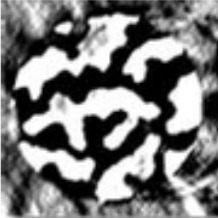
The research into this new technique has great potential for its future in high-resolution magnetic x-ray imaging.
Physics researchers collaborate with Diamond Light Source to study magnetic materials
Impressive results from these experiments at Diamond Light Source on magnetic lensless imaging by Fourier transform holography using extended references have been published this week in Optics Express, the journal of the Optical Society of America.
Researchers Thomas Duckworth and Feodor Ogrin from the Electromagnetic Materials research group in the Physics department have been collaborating with research teams from Diamond Light Source, Leeds and Grenoble, to study complex magnetic systems and further our understanding of their behaviour. The behaviour of magnetic materials on the nanometer scale and the ability to control their magnetic properties is of central importance for new spintronic devices.
Fourier transform holography is a well established lensless technique for imaging magnetic domains with perpendicular and in-plane magnetic anisotropy. The novel technique, known as holography with extended reference by autocorrelation linear differential operator (HERALDO), promises to be more efficient than standard Fourier transform holography, where small holes are used to define the reference beam. The extended reference object generates an increased intensity transmitted through the sample, so reduces the counting time required to record a hologram. Manufacturing the extended object also proves easier with the current patterning procedure.
The team used a focused ion beam (FIB) to mill a narrow slit through an opaque gold mask in order to provide a holographic reference source. Experiments were performed on the I06 Nanoscience beamline at Diamond Light Source using high brilliance synchrotron radiation, where images of magnetic domains in a Co/Pt multilayer thin film with perpendicular magnetic anisotropy were attained. Magnetic contrast was achieved via x-ray magnetic circular dichroism.
Thomas Duckworth said “We are proud of the results we attained from this relatively new imaging technique and see great potential for its future in high-resolution magnetic x-ray imaging. Using x-rays for imaging is useful in many ways such as being able to probe buried interfaces deep within samples at extremely high resolutions. The current development of fourth generation x-ray sources and the opportunities that lie ahead are very exciting. With these new x-ray sources comes huge intensities and the possibility to study dynamic behaviour of materials on a femtosecond timescale.”
The technique’s ability to directly image magnetic configurations within an applied field could benefit the advancement of magnetic logic and magnetic race track memory devices where the understanding of the propagation and controlled pinning of magnetic domain walls along nanowires is desired.
The work was funded by the Centre for Material Physics and Chemistry (CMPC) of the Science and Technology Facilities Council (STFC), UK and the Engineering and Physical Sciences Research Council (EPSRC), UK.
For more information please see the paper itself: Thomas A. Duckworth, Feodor Ogrin, Sarnjeet S. Dhesi, Sean Langridge, Amy Whiteside, Thomas Moore, Guillaume Beutier, and Gerrit van der Laan, "Magnetic imaging by x-ray holography using extended references," Opt. Express 19, 16223-16228 (2011).
Date: 17 August 2011
